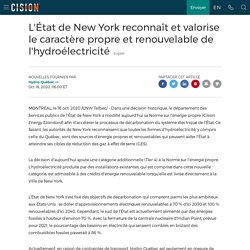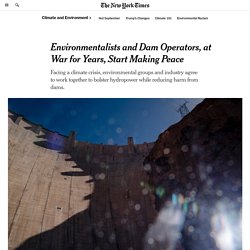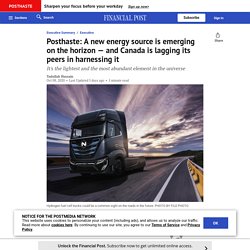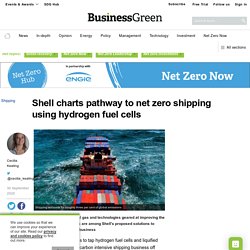

L'État de New York reconnaît et valorise le caractère propre et renouvelable de l'hydroélectricité. MONTRÉAL, le 16 oct. 2020 /CNW Telbec/ - Dans une décision historique, le département des Services publics de l'État de New York a modifié aujourd'hui sa Norme sur l'énergie propre (Clean Energy Standard) afin d'accélérer le processus de décarbonation du système électrique de l'État.

Ce faisant, les autorités de New York reconnaissent que toutes les formes d'hydroélectricité, y compris celle du Québec, sont des sources d'énergie propres et renouvelables qui peuvent aider l'État à atteindre ses cibles de réduction des gaz à effet de serre (GES). La décision d'aujourd'hui ajoute une catégorie additionnelle (Tier 4) à la Norme sur l'énergie propre. L'hydroélectricité produite par des installations existantes, qui est comprise dans cette nouvelle catégorie, est admissible à des crédits d'énergie renouvelable lorsqu'elle est livrée directement à la Ville de New York. Le solaire est le nouveau roi de l’électricité selon l’AIE. (Agence Ecofin) - Les énergies renouvelables connaîtront une croissance accélérée au cours des prochaines décennies et le solaire en sera la principale locomotive selon l’AIE.

World Energy Outlook 2020 – Analysis - IEA. The era of growth in global oil demand comes to an end within ten years, but the shape of the economic recovery is a key uncertainty.

In both the STEPS and the DRS, oil demand flattens out in the 2030s. However, a prolonged economic downturn knocks more than 4 million barrels per day (mb/d) off oil demand in the DRS, compared with the STEPS, keeping it below 100 mb/d. Changes in behaviour resulting from the pandemic cut both ways. The longer the disruption, the more some changes that eat into oil consumption become engrained, such as working from home or avoiding air travel.
However, not all the shifts in consumer behaviour disadvantage oil. Un momentum favorable aux investissements au Québec - Canadian Renewable Energy Association. Jean-François Nolet | October 14, 2020 Although Quebec has been a leader in the development and deployment of wind energy since the early 2000s, the pace has somewhat slowed since the last call for tenders in wind energy, dating back to 2014.

As different phases of the Romaine hydroelectric complex and approximately 4,000 MW of wind energy were put into operation, the demand for electricity was stagnating and efficiency measures reduced electricity demand by 10TWh, making new renewable energy projects, no matter how innovative and promising for the economy, suddenly more difficult to justify. But the situation is evolving. And quickly, at that. Efforts to promote Quebec’s green electricity as an economic advantage are coming to fruition. In the fall of 2019, Hydro-Québec Distribution published a new version of its Electricity Supply Plan, which presents forecasts up to 2029. Environmentalists and Dam Operators, at War for Years, Start Making Peace. WASHINGTON — The industry that operates America’s hydroelectric dams and several environmental groups announced an unusual agreement Tuesday to work together to get more clean energy from hydropower while reducing the environmental harm from dams, in a sign that the threat of climate change is spurring both sides to rethink their decades-long battle over a large but contentious source of renewable power.

The United States generated about 7 percent of its electricity last year from hydropower, mainly from large dams built decades ago, such as the Hoover Dam, which uses flowing water from the Colorado River to power turbines. But while these facilities don’t emit planet-warming carbon dioxide, the dams themselves have often proved ecologically devastating, choking off America’s once-wild rivers and killing fish populations. The new agreement signals a desire to de-escalate this long-running war. Mr. Opinion: The world is betting on clean hydrogen – and Canada needs to get in the game. Merran Smith is the executive director and Sarah Petrevan is the policy director of Clean Energy Canada, a program at Simon Fraser University’s Centre for Dialogue.

Hydrogen as an energy source is hardly new. After all, it was hydrogen that fuelled the first internal combustion engines. But there are plenty of innovations changing how it’s created and how it will be used in the coming decades – and that’s getting people talking. The International Energy Agency cited a “growing international consensus that clean hydrogen will play a key role in the world’s transition to a sustainable energy future.”
Research service BloombergNEF, meanwhile, estimates that clean hydrogen could meet up to nearly a quarter of the world’s energy demand by 2050. The reason for these excited forecasts? The inflection point in hydrogen is now upon Canadians. Posthaste: A new energy source is emerging on the horizon — and Canada is lagging its peers in harnessing it. Good morning!

Hydrogen is the new shiny penny in the energy space. The fuel source can be harnessed from either fossil fuels or renewable energy, and the latter is being touted as the ideal way to combat climate change — hence the excitement. But not every hydrogen molecule is created equal. Grey, black, and brown hydrogen is produced from fossil fuels, while blue hydrogen is produced from fossil fuels but with carbon capture and storage. A New Hope - Clean Energy Canada. Shell charts pathway to net zero shipping using hydrogen fuel cells.
Hydrogen, liquified natural gas and technologies geared at improving the energy efficiency of ships are among Shell's proposed solutions to decarbonise its shipping business Shell has unveiled plans to tap hydrogen fuel cells and liquified natural gas to wean its carbon intensive shipping business off heavy fuel oil as it works toward its aim of becoming a 'zero emissions company' by 2050.

Home - UTC Power Grid.